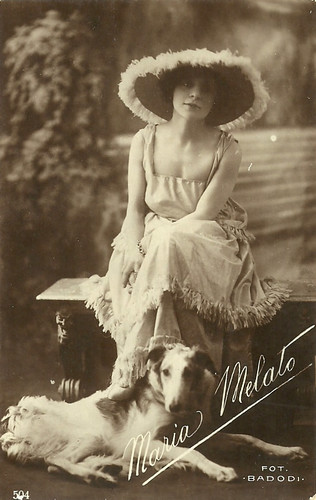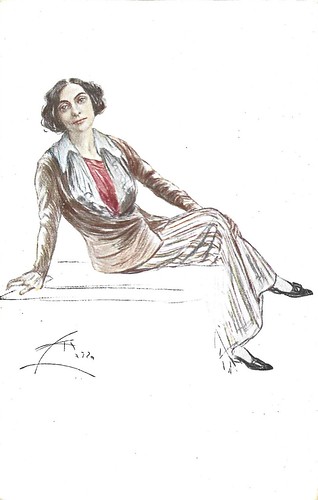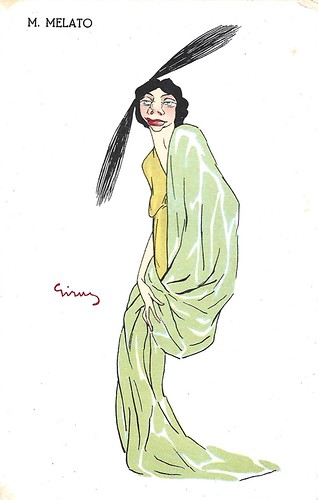Italian actress Maria Melato (1885-1950) appeared in the theatre, on radio, and in the cinema. Her films included Ritorno / Return (1914), Anna Karenina (1917), and Il volo degli aironi / The Flight of the Herons (1920). Unfortunately, all her films are considered lost.

Italian postcard by Ed. A. Traldi, Milano, no. 350. Photo: Badodi, Milano.

Italian postcard by Ed. A. Traldi, Milano, no. 3507. Photo: Badodi, Milano.

Italian postcard by Fotocelere, Turin.

Italian postcard by Vettori, Bologna. Photo: Trevisani, Bologna.

Italian postcard by Foto d'Arte Vettori Bologna, no. 3043.

Italian postcard by G. Vettori, Bologna, no. 186. Photo: Badodi, Milano
Maria Melato was born in 1885 in Reggio Emilia as the daughter of the fencing instructor Silvio Melato and the noble lady Elisa Friggieri. Already in childhood, Melato manifested a penchant for acting.
She began her very rich artistic career first at the Berti-Masi company in 1903, then served as a love interest in the company of Teresa Mariani and Vittorio Zampieri. Later, she became the first young actress (prima attrice giovane) in the company of Irma Gramatica and Flavio Andò.
But her real maturation occurred under the severe and passionate leadership of Virgilio Talli, the greatest artistic director of his time. It was with him that, from 1909 to 1921, Melato composed a famous triad with Annibale Betrone and Alberto Giovannini. Until 1918, they performed a classical repertoire. Afterwards, they experimented with more current texts that treated modern issues, such as those by Luigi Pirandello, e.g. 'Così è (se vi pare)', and other authors such as Rosso di San Secondo, Bontempelli, and Gabriele D'Annunzio.
Maria Melato also tried her hand at film acting. Her film debut was Ritorno / Return (Luca Comerio, 1914) with D’Annunzio’s son, Gabriellino, co-starring.
It was followed by a series of films directed by Ugo Falena: Anna Karenina (Ugo Falena, 1917) with Fabienne Fabrèges, Le due Marie (Mario Corsi, Ugo Falena, 1918), Il volo degli aironi (Ugo Falena, 1920) with Ileana Leonidoff, Il trittico d’amore (Ugo Falena, 1920) with Mimi Aylmer and Eduardo Scarpetta, and Le due esistenze (Ugo Falena, Giorgio Ricci). Unfortunately, all are lost.

Italian postcard, no. 408. Photo: Massaglia, Torino.

Italian postcard by Photo Ed. Soc. Anon. It. Bettini, Roma, no. 181.

Italian postcard by Photo Ed. Soc. Anon. It. Bettini, Roma, no. 182.

Italian postcard by Photo Ed. Soc. Anon. It. Bettini, Roma, no. 186.

Italian postcard by E. A. Traldi, Milano, no. 503.

Italian postcard by Ed. A. Traldi, Milano, no. 504. Photo: Badodi, Milano.
In 1921, a turning point happened: Maria Melato left Virgilio Talli’s company and became 'capocomica' (head actor) with Annibale Betrone. Her greatest period of artistic fervour started, in which she was busy with every aspect of 'doing theatre': the direction or adaptation of texts, the formation of actors, as well as designing costumes. From 1922 onward, she formed various theatre companies. In 1923 and 1925, she brought her stage performances to Latin America with great success. In 1927, she triumphed at the Vittoriale with her interpretation of 'La figlia di Jorio' (Jorio's Daughter) by Gabriele D'Annunzio.
In the 1930s, Melato had to return to more traditional themes and authors, satisfying the guidelines of the moment and forming her own company again with Betrone and with direction by Luigi Carini. Compared by her admirers to Eleanore Duse for their same emotional tension and heightened sensitivity. She possessed a vocal range that led her to excessive phonics complacency, leading to malicious accusations of 'singing'.
In the three years 1937-1940, she was the star of Oscar Wilde's 'The Duchess of Padua' and 'Tosca' by Victorien Sardou, opposite Piero Carnabuci and Gino Sabbatini, while in the postwar years she revisited D'Annunzio, Mario Praga, Dario Niccodemi, Jean Cocteau and others. In particular, in 1938, when she was associated with the Company Ninchi-Abba-Pilotto.
During the war years, she played some minor parts in Italian sound films, such as La principessa del sogno (Maria Teresa Ricci, Roberto Savarese, 1942) with Annibale Betrone, Irasema Dilian, and Antonio Centa. She acted opposite Adriana Benetti and Massimo Serato in Quartieri alti (Mario Soldati, 1945), about a young man kept by a rich and old aristocratic lady, who has two actors posing as his parents, to impress his beloved.
Following the vicissitudes of the war, the actress, now in her sixties, began to lose ground. Left for her were just some second-category performances and radio work. So she left the stage in 1948 with 'Casa paterna' (Heimat/Homeland) by Hermann Sudermann, before retiring to Versilia. Maria Melato died in 1950 in Lucca after a bad fall from her train while trying to reach Turin for the radio programme 'La sacra fiamma' (The sacred flame) by W. Somerset Maugham. She was 64. She lies buried next to stage and screen actor Romolo Valli in the monumental cemetery of Reggio Emilia. Maria Melato had a son, Luciano, born in 1909.

Italian postcard by Ed. A. Traldi, Milano, no. 884. Photo: Badodi.

Italian postcard by CENV in the Le Dive series, no. 5.

Vintage postcard by GMP. Portrait of Maria Melato by Giuseppe Amisani.

Italian postcard by A.G.F. Sent by mail in 1919.

Italian collectors card by S.P.E.R.A. Unione Cooperativa.

Italian postcard, no. 1809. Design by Aldo Mazza.

Italian postcard by CCM (Cesare Capello, Milano). Caricature by Girus (Giuseppe Russo, 1888-1960). Cesare Capello founded his firm CCM in 1908. Between 1919 and 1927, the publisher used a logo with the letters CCM. In 1930, the name was changed to Cecami.
Sources: Wikipedia (Italian and English), and IMDb.
This post was last updated on 26 July 2025.

Italian postcard by Ed. A. Traldi, Milano, no. 350. Photo: Badodi, Milano.

Italian postcard by Ed. A. Traldi, Milano, no. 3507. Photo: Badodi, Milano.

Italian postcard by Fotocelere, Turin.

Italian postcard by Vettori, Bologna. Photo: Trevisani, Bologna.

Italian postcard by Foto d'Arte Vettori Bologna, no. 3043.

Italian postcard by G. Vettori, Bologna, no. 186. Photo: Badodi, Milano
Maturing under the severe and passionate leadership of Virgilio Talli
Maria Melato was born in 1885 in Reggio Emilia as the daughter of the fencing instructor Silvio Melato and the noble lady Elisa Friggieri. Already in childhood, Melato manifested a penchant for acting.
She began her very rich artistic career first at the Berti-Masi company in 1903, then served as a love interest in the company of Teresa Mariani and Vittorio Zampieri. Later, she became the first young actress (prima attrice giovane) in the company of Irma Gramatica and Flavio Andò.
But her real maturation occurred under the severe and passionate leadership of Virgilio Talli, the greatest artistic director of his time. It was with him that, from 1909 to 1921, Melato composed a famous triad with Annibale Betrone and Alberto Giovannini. Until 1918, they performed a classical repertoire. Afterwards, they experimented with more current texts that treated modern issues, such as those by Luigi Pirandello, e.g. 'Così è (se vi pare)', and other authors such as Rosso di San Secondo, Bontempelli, and Gabriele D'Annunzio.
Maria Melato also tried her hand at film acting. Her film debut was Ritorno / Return (Luca Comerio, 1914) with D’Annunzio’s son, Gabriellino, co-starring.
It was followed by a series of films directed by Ugo Falena: Anna Karenina (Ugo Falena, 1917) with Fabienne Fabrèges, Le due Marie (Mario Corsi, Ugo Falena, 1918), Il volo degli aironi (Ugo Falena, 1920) with Ileana Leonidoff, Il trittico d’amore (Ugo Falena, 1920) with Mimi Aylmer and Eduardo Scarpetta, and Le due esistenze (Ugo Falena, Giorgio Ricci). Unfortunately, all are lost.

Italian postcard, no. 408. Photo: Massaglia, Torino.

Italian postcard by Photo Ed. Soc. Anon. It. Bettini, Roma, no. 181.

Italian postcard by Photo Ed. Soc. Anon. It. Bettini, Roma, no. 182.

Italian postcard by Photo Ed. Soc. Anon. It. Bettini, Roma, no. 186.

Italian postcard by E. A. Traldi, Milano, no. 503.

Italian postcard by Ed. A. Traldi, Milano, no. 504. Photo: Badodi, Milano.
Malicious accusations of 'singing'
In 1921, a turning point happened: Maria Melato left Virgilio Talli’s company and became 'capocomica' (head actor) with Annibale Betrone. Her greatest period of artistic fervour started, in which she was busy with every aspect of 'doing theatre': the direction or adaptation of texts, the formation of actors, as well as designing costumes. From 1922 onward, she formed various theatre companies. In 1923 and 1925, she brought her stage performances to Latin America with great success. In 1927, she triumphed at the Vittoriale with her interpretation of 'La figlia di Jorio' (Jorio's Daughter) by Gabriele D'Annunzio.
In the 1930s, Melato had to return to more traditional themes and authors, satisfying the guidelines of the moment and forming her own company again with Betrone and with direction by Luigi Carini. Compared by her admirers to Eleanore Duse for their same emotional tension and heightened sensitivity. She possessed a vocal range that led her to excessive phonics complacency, leading to malicious accusations of 'singing'.
In the three years 1937-1940, she was the star of Oscar Wilde's 'The Duchess of Padua' and 'Tosca' by Victorien Sardou, opposite Piero Carnabuci and Gino Sabbatini, while in the postwar years she revisited D'Annunzio, Mario Praga, Dario Niccodemi, Jean Cocteau and others. In particular, in 1938, when she was associated with the Company Ninchi-Abba-Pilotto.
During the war years, she played some minor parts in Italian sound films, such as La principessa del sogno (Maria Teresa Ricci, Roberto Savarese, 1942) with Annibale Betrone, Irasema Dilian, and Antonio Centa. She acted opposite Adriana Benetti and Massimo Serato in Quartieri alti (Mario Soldati, 1945), about a young man kept by a rich and old aristocratic lady, who has two actors posing as his parents, to impress his beloved.
Following the vicissitudes of the war, the actress, now in her sixties, began to lose ground. Left for her were just some second-category performances and radio work. So she left the stage in 1948 with 'Casa paterna' (Heimat/Homeland) by Hermann Sudermann, before retiring to Versilia. Maria Melato died in 1950 in Lucca after a bad fall from her train while trying to reach Turin for the radio programme 'La sacra fiamma' (The sacred flame) by W. Somerset Maugham. She was 64. She lies buried next to stage and screen actor Romolo Valli in the monumental cemetery of Reggio Emilia. Maria Melato had a son, Luciano, born in 1909.

Italian postcard by Ed. A. Traldi, Milano, no. 884. Photo: Badodi.

Italian postcard by CENV in the Le Dive series, no. 5.

Vintage postcard by GMP. Portrait of Maria Melato by Giuseppe Amisani.

Italian postcard by A.G.F. Sent by mail in 1919.

Italian collectors card by S.P.E.R.A. Unione Cooperativa.

Italian postcard, no. 1809. Design by Aldo Mazza.

Italian postcard by CCM (Cesare Capello, Milano). Caricature by Girus (Giuseppe Russo, 1888-1960). Cesare Capello founded his firm CCM in 1908. Between 1919 and 1927, the publisher used a logo with the letters CCM. In 1930, the name was changed to Cecami.
Sources: Wikipedia (Italian and English), and IMDb.
This post was last updated on 26 July 2025.
No comments:
Post a Comment